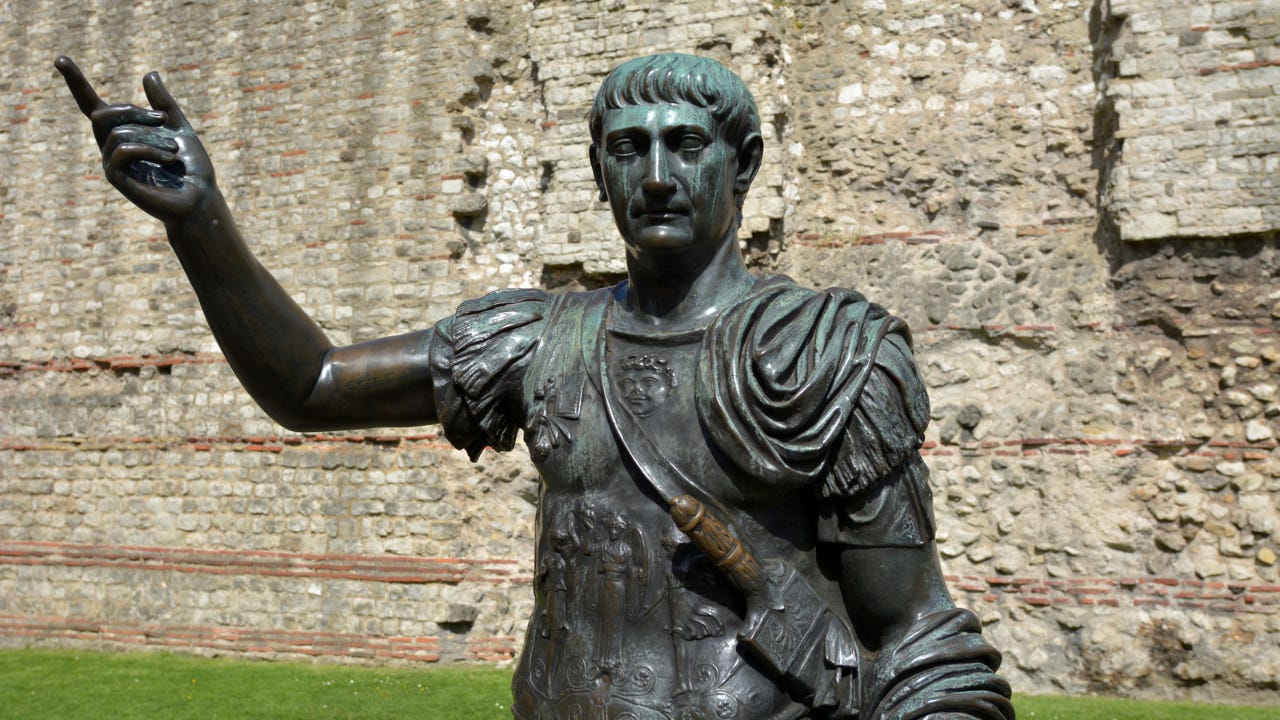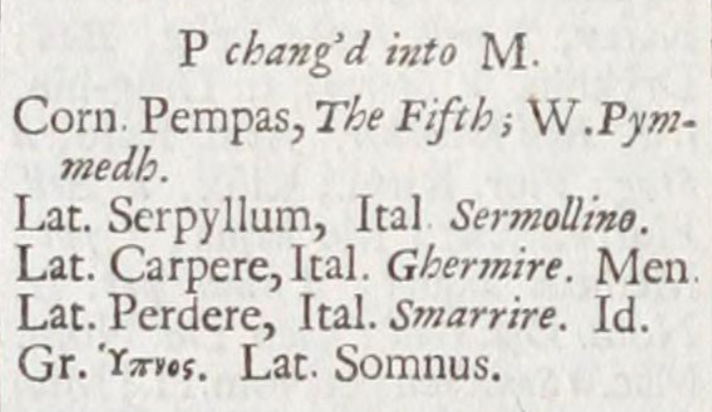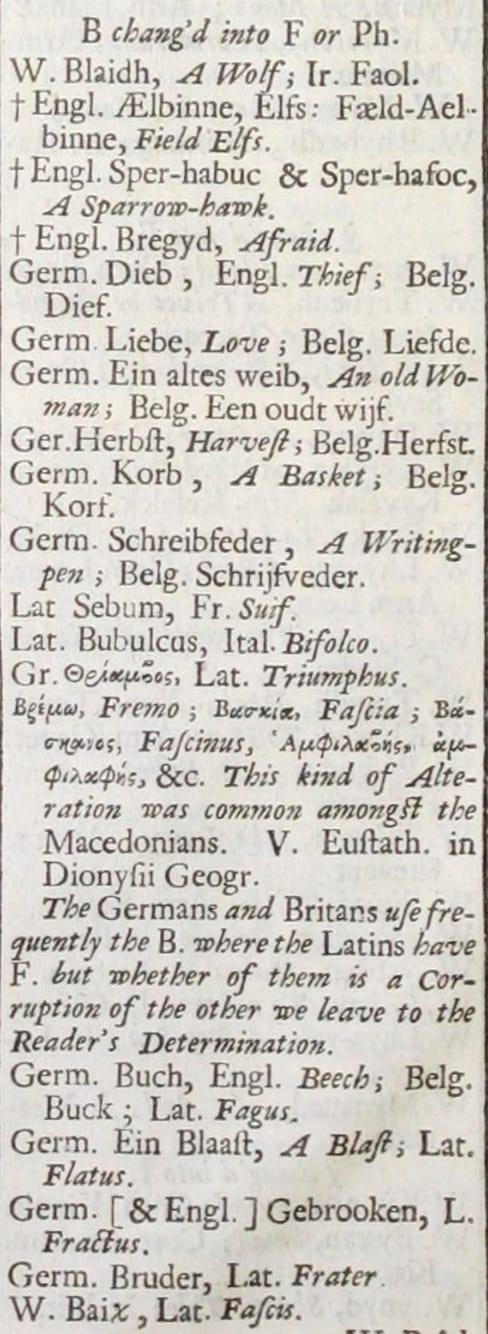Fresh Batch #127: Liquid Interchanges
The Master Class on British and Italian Philology
This will likely be the final post of 2023. I hope you enjoyed what I contributed over the last year, and may 2024 bless us with the abundance to keep it going. Without further adieu, here we go!
The letter P has become a prominent key to unlocking the mysteries of ancient language. Welshman Edward Lhuyd is responsible for helping me grasp the significance, and had I not been researching Etruscan archeology and the ancient alphabets of Italy for a year prior to examining Archaeologica Britannica, as well as learning the fact that Punic is Sicilian Phoenician years ago, through scholars such as Thomas Astle and Godfrey Higgins, as well as the affinity between Punic-Maltese and the Irish languages from scholars like Charles Vallancey, in addition to the affinity between the Roman and Celtic languages, I’m not sure I would’ve appreciated the masterful knowledge contained in its pages.
None of these men made the claim that the Phoenicians are ancient Italians, that the Pelasgi were Etruscans, but the one who gave me the idea was William Betham, who wrote that Italy was the first great colony of the Phoenicians, yet he was still under the impression that their origins were in the orient. Historian Dionysius of Halicarnassus was the one who wrote that, according to Myrsilius of Lesbos, the same people were called Tyrrhenians and Pelasgi by the rest of the world, which sealed the deal for me because the Tyrrhenians are the Etruscans (look up the Tyrrhenian sea) and, according to the status quo, the Pelasgian alphabet is of Phoenician original and the Pelasgians were the maritime empire of the Mediterranean 232 years prior to the Phoenicians. The ability to consider all perspectives, as well as the artifacts that came to light through brilliant men such as Michael Grant, who demonstrated that there is no evidence of mass migration into Italy from the north or east in the 1st millennium BC, enabled me to see things the way these men weren’t afforded during their time in this world. Dionysius of Halicarnassus solidified my opinion by writing that they who come nearest to the Truth are those who acknowledge that the Etruscans were indigenous to Italy. But it was Suetonius whose words helped me unlock the meaning of my family’s name, which is Etruscan (you will find everything but the Truth when searching for the answers through the status quo), and I was guided to this citation by Godfrey Higgins. It was Reverend Robert Taylor and Edward Gibbon who helped me understand the lies that have been perpetuated about my family and the history of Italy, specifically of the Etrusco-Roman empire. Evidence suggests that Rome was quasi-Etruscan all the way up to the first century BC, yet the absence of Etruscan history, along with the fables that Roman history is embroiled in, suggests something terrible happened and history was fabricated when the priest class reckoned the new era of Christianity.
Pompeii was an important site going back to the Etrusco-Phoenician maritime empire, a critical location that a region can’t afford to lose without suffering substantial economic decline and social strife. The following is significant to my suspicion of Italy’s history being covered up by the Church because it is an Etruscan in Roman clothing, dated to the 1st century BC. This demonstrates that the Etruscan language was used at least till the time of Julius Caesar, whose last name is Etruscan. I suspect the mythology of the Caesars and their legendary history is not true, but are a fabrication, and the real history that was obfuscated is of an Etrusco-Phoenician empire, which was essentially inherited or reorganized by the Roman one.
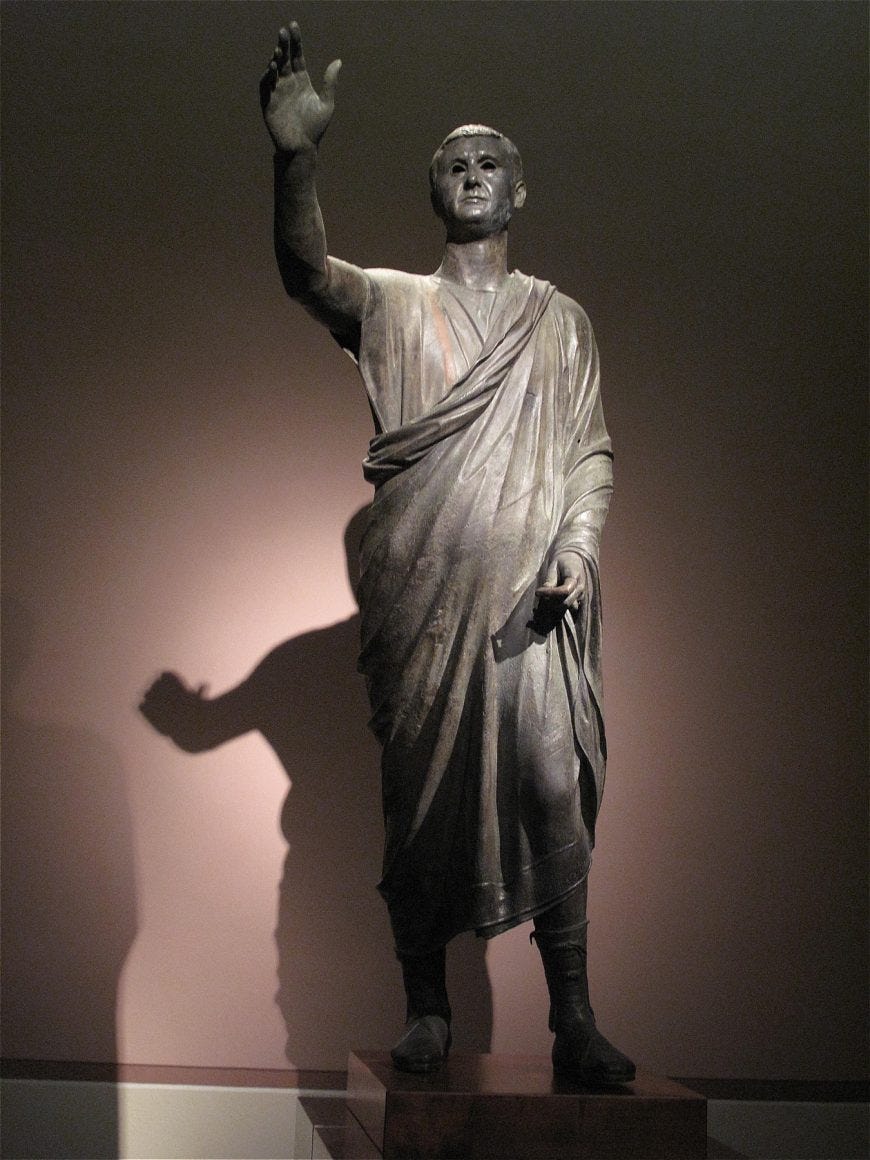
According to Dr. Jeffrey A. Becker, “The lower hem of the short toga carries an Etruscan inscription: “auleśi meteliś ve[luś] vesial clenśi / cen flereś tece sanśl tenine / tu θineś χisvlicś” which can be interpreted as reading, “To (or from) Auli Meteli, the son of Vel and Vesi, Tenine (?) set up this statue as a votive offering to Sans, by deliberation of the people” (TLE 651; CIE 4196).” (The θ acts like Th in thought, while the χ functions like Ch in Christ.)
There is not one word directing the persecution of Christians in the entire body of Roman Law, and simply put, it is because Christian and Jewish fables, purported as history, did not occur. There is not one Greek writer who mentioned Moses prior to c. 270 AD. The entire history given to us by Abrahamic cults is, in fact, based on forgeries and priestcraft, constantly projecting what they are (liars, forgers, and heretics) onto good people who spoke the Truth. There is not one work pertaining to the gospels that was written prior to 6th century AD, which begets forgeries like the Dead Sea Scrolls as the dying priest class tries to revive itself before the techno-sorcerers from Alpha Centauri take over with AI (this is a joke for all my Cyberpunk 2077 homies). There was no Moses, no Noah, no Jesus, none of it. The very people who claim their adversary is the Father of Lies have done the bidding of that proverbial Satan by spreading the lies of Mosaic history, claiming to be persecuted for being Christian when, in fact, they were not. This Abrahamic trend of bearing false witness goes back thousands of years and is still used today to justify atrocities and destroy anyone who would call out their lies. Not one historian notices Israelites, Solomon’s Temple, or anything else related to the scriptures during the time they would’ve been noticed. Even the father of ecclesiastical history acknowledged that Porphyry wrote Israel was a Phoenician name for Saturn (Kronos), and those kinds of Truths were why Porphyry’s work was committed to the flame. This unquenchable thirst for victimhood provides wicked people with a liability shield that made institutions fortunes for thousands of years and destroyed western culture, along with the inherent virtues that gave rise to the happiest period in human history. The only archetype you’ll find pertaining to the name Jesus from the first century is the Celtic Esus, God of War, which is the Gothic Odin, who is Aesus, named after the Etruscan word for both God (Aesar) and the sun (Esar).
The only place where the lies can’t be covered up is the knowledge of philology. Language is the achilles heel of the institutional deception and ignorance we face because the moment a forgery is committed, it is confined to the language of the era in which it was made. The affinity that Irish has to Punic (Sicilian Phoenician) and that the Celtic has to the Roman, and subsequently Sanskrit, is uncanny. It tells a much different story than the ones you’ll find in the history books.
Over the last couple posts and the ones soon to come, I will make the case that Irish is likely the oldest language of Britain, or the remnant that kept the closes affinity to the one spoken by the original settlers, even though it likely has greater difference to it than Italian has to Latin. The other languages that diverged from that original stock took the forms of Welsh, Armoric, and Cornish, which are the languages found where the earliest Etrusco-Phoenician settlements of Southwest Britain were. I call that original stock the Holy Sailors because I’m not ready to make claims about which region of the Mediterranean they came from, or which Etruscan city-state they came from, because there isn’t enough left of the old languages. I am, however, comfortable claiming what I have already, namely, that the affinities of the languages indicate an ancient Italian origin.
The languages of Britain are not so different from the Irish once the changing of the letters is comprehended, in terms of their words, not necessarily their structures. The divergences from each other are not as extreme as they initially appear. Now, it may turn out that some of these languages are older than Irish, such as the Cornish, Armoric, or Welsh, but no one has demonstrated their affinity to what’s left of the Punic and the Irish seems to retain more of the original Phoenician words with their meanings. It’s another reason why I’m not making specific claims yet. This area of research is like a new world that only a few have been to, and I’m the only one alive (that I’m aware of) who’s doing it in this capacity, which is why I’m putting it out there. For anyone who disagrees, show me the work of one person who’s demonstrated that the Etruscans, Phoenicians, Pelasgi, etc. are all remnants of the same stock from Italy, not the orient, who peopled Britain. Though most Britains speak English and have forgotten their native tongues, or never learned them, there must be some who are fluent in these languages that can get together and explore this further within the context of the Punic affinity.
There are words in Welsh that are identical to Hebrew but have different meaning. For example the Welsh have a tea bread called bara brith, pronounced the same as the Hebrew words for creation/formation (bara; ברא, or bra) and covenant (berith; ברית, or brit). I transliterate literally because that’s the only way you can see the bones of the word and not presume the vowels. Now, this tea bread may have been named by someone who spoke Hebrew. It doesn’t prove anything. But this is not an isolated idea I’m presenting. Henry Rowlands demonstrated that, out of the 300 Hebrew words that paralleled European ones, more than half of those Hebrew words had affinity and resemblance with the Welsh. According to him, there are more sounds in the Welsh that agree with the Hebrew, than there are in all other languages put together. (Mona Antiqua Restaurata, p. 271, published in 1766). He wrote, “And our British, even in the state it is at present (for I meddle not with any, or very few of its old obsolete words) having more sounds in it, agreeing with that primitive tongue, than all the rest put together, is also an argument that this British tongue was in its first structure and origin one of the primary issues of it; and that if we give way to criticism and etymology, it must be from that original language that we are to derive and account for many names in our British tongue, which otherwise would be unaccountable.”
Rowlands thought that this affinity was from the Phoenician tin-traders that peopled Britain, but he differs from me in the presumption that Hebrew is a primitive tongue, and that Phoenicians were connected to Mosaic history. I do not think Hebrew was ever a spoken language. It was a written one for the initiated. I also don’t think the Phoenicians are from the orient. I think it is a placeholder term for those who were also called Etruscan. I think this writing system comes out of Italy because the Pelasgian is of Phoenician original and the Etruscans were called both Tyrrhenians and Pelasgians by the rest of the world (according to Myrsilius of Lesbos, cited by Dionysius of Halicarnassus). Hebrew takes a later version of the Phoenician alphabet, not its early one of thirteen letters, but has scarcely any affinity to what remains of Phoenician. I suspect all of this indicates that the Hebrew system we know of has its origins in Britain, the implications being that it uses the universal priestly writing system with a Chaldean syntax, and that it’s only as old as the Middle Ages, hence the necessity of the point system, something that isn’t present in the Old Synagogue Hebrew, hence the claims that it was a dead language and thus the priests (Cohens) needed to introduce these points to teach people how to pronounce the words. I also think the affinity of this system to what is found in North Africa and Asia is a result of the empire expanding its trade from Europe, not from the priests or cultures of India, as presumed in Mosaic history. This isn’t a claim yet, but it’s my suspicion. It may turn out to be nonsense, but if it turns out to be correct, then it may link the Caledonians (Scottish) to the Chaldeans, especially when considering Scottish Rite Masonry and the real meaning of Hebrew pertaining to one who has passed over the Hebraic degrees of initiation in masonry, which dates as far back as priests building temples from stone. Not every priest was a mason, but every mason was a priest. They had to know astronomy, a priestly profession, in order to build temples that correspond to the cycles of the cosmos. This is the type of knowledge most people aren’t ready to confront yet, but I assure you, I don’t write about things like this on a whim. Scotland, in addition to being called Caledonia, was also called Albania (pronounced exactly like Albegna, in Etruria, Italy), and I also suspect somewhere in this research will be an explanation of why the language of Albania (the nation) is drastically different from its neighbors in the east, on account of it being descended from one of the ancient Italian languages that had no affinity to Indo-European ones.
It was noticed that the interchangeability of P and B began with the Pelasgians, who were called Dioi Pelasgi (Holy Sailors), and this is seen in the ancient Italian languages such as Umbrian, Oscan, etc. The following is a continuation from the previous Fresh Batch, so if it seems out of place, it’s because you’re not a paid member and are missing out on wealth of information that my Substack contains, which is comparable to the portion of an iceberg beneath the surface.
P Changed into K, C, or Q
Lhuyd wrote (Arch. Brit. p. 20.), “It’s very Remarkable, that there are scarce any words in the Irish (besides what are borrow’d from the Latin or some other Language) that begin with P in so much that in an Ancient Alphabetical Vocabulary, I have by me, that Letter is omitted; and no less observable that a considerable number of those words whose Initial Letter it is, in the British; begin in that Language with a K or (as they constantly write) C as partly appears by the following examples.”

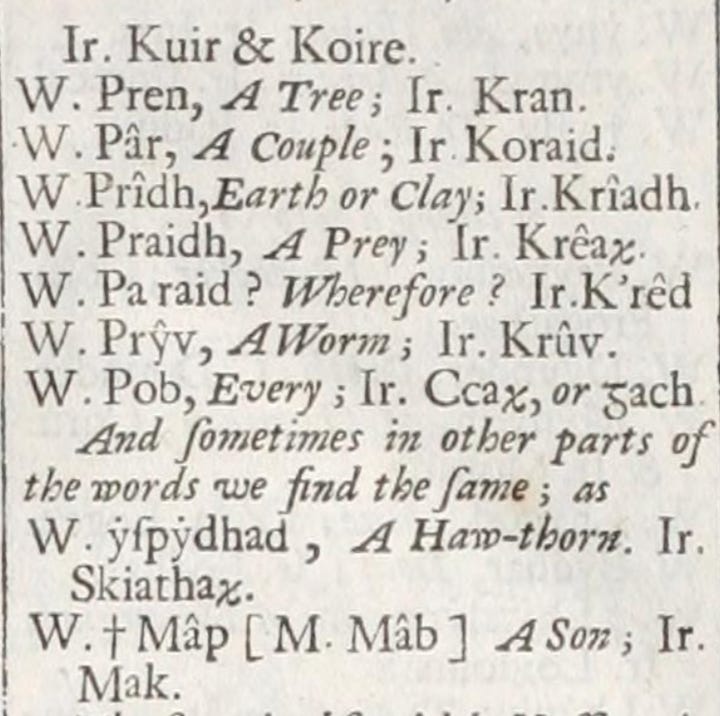
P changed into M
P changed into Sh.
P changed into T
P changed into V consonant
I don’t feel like transliterating this because at some point I expect you to go through my work and learn these alphabets on your own, but for those who are new, look for the Greek symbol Π, or π; that’s their P. In the first example, Lepis (Λεπίς) is written, and then compared to the Latin Levis.
The presumption, in this instance, is that the Latin is changing the P into V, but if you recall the premise of Lhuyd’s observation, which is that P changed into K, C, and Q, then it is contradictory because the Latin word for Wolf is Lupus, and the Greek counterpart adheres to the P changing into K, which is Lykos (Λύκος). According to the order of Lhuyd’s observation, it would be an example of Greek descending from Latin, or of K changing into P and not necessarily P changing into K.
B changed into D
B changed into G
B changed into M
B changed into P
Regarding the B changing into P, Lhuyd wrote (Ib. p. 21.), “This alteration and the Converse; as well as other such like, are so natural, that they need not be much exemplified.”
B changed into V Consonant
Lhuyd wrote (Ib. p. 21), “The change of B into V consonant, is also no less easy. The Greeks and Spaniards often pronounce the B we find, as an V consonant and the Britans (as we shall elsewhere have occasion to observe) us’d formerly no other, than B or M as neither do the Irish at this day; only of later Ages their Grammarians have very well distinguished this, and all their other Mutes upon change of their Primary Pronunciation, with a point above the letters, or an H after.”
Lhuyd added (Ib. p. 21.), “The B was doubtless pronounced by some, as an V consonant in the time of the Romans, else we should never find on their old Monuments Vene for Bene; Livertus for Libertus; Inconparavilis for incomparabilis.”
If you’re not familiar with the significance of this system, you’ll want to look into Spirit Whirled Books V & VI, and examine the cultural diffusion between the Mediterranean, Britain, and the Americas that occurred long before the status quo is willing to acknowledge.
The philological master class of the British and Italian languages will continue on the other side.
Become a member to access the rest of this article.
Keep reading with a 7-day free trial
Subscribe to Ancient History, Mythology, & Epic Fantasy to keep reading this post and get 7 days of free access to the full post archives.


